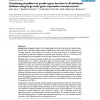820 search results - page 10 / 164 » Using Multiple Alignments to Improve Gene Prediction |
BMCBI
2004
13 years 7 months ago
2004
Background: In a previous paper, we introduced MUSCLE, a new program for creating multiple alignments of protein sequences, giving a brief summary of the algorithm and showing MUS...
BMCBI
2007
13 years 7 months ago
2007
Background: Arabidopsis thaliana is the model species of current plant genomic research with a genome size of 125 Mb and approximately 28,000 genes. The function of half of these ...
NAR
2002
13 years 7 months ago
2002
PALS db is a collection of Putative Alternative Splicing information from 19 936 human UniGene clusters and 16 615 mouse UniGene clusters. Alternative splicing (AS) sites were pre...
BMCBI
2005
13 years 7 months ago
2005
Background: Alternative splicing (AS) is now considered as a major actor in transcriptome/ proteome diversity and it cannot be neglected in the annotation process of a new genome....
BMCBI
2004
13 years 7 months ago
2004
Background: Multiple sequence alignment algorithms are very important tools in molecular biology today. Accurate alignment of proteins is central to several areas such as homology...

